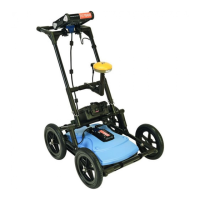Line Scan
© Radiodetection 2016 47 RD1500 Operation Manual
Soil Types – to vary between the following mediums (with the pre-set Soil Cal value
shown in brackets):
o very wet (60)
o wet (80)
o moist (100)
o dry (120)
o very dry soil (150)
o air (300)
If you do have a suitable hyperbola on the screen from a subsurface target, press:
Soil Cal –to determine a more accurate Soil Cal. Touch the screen to move the red
hyperbola (Figure 8-13a).so that it lies over a real hyperbola from the ground (Figure 8-
13b). Use the 4-way directional keypad to fine tune the movements. Then use the + and
– buttons on the Soil Cal button to widen or tighten the shape. Once the shape is
matched, as shown, you now have the correct Soil Cal and the measured depths will be
most accurate. Press Apply to use this value. If you get a Soil Cal near 300, this could
be an Air Wave (Section 7.5), and you should calibrate to a different hyperbolic
response.
Figure 8-13: Adjusting Soil Cal, a) initial screen. b) moving the red hyperbola over a hyperbolic
response from a subsurface target
Interp
Short for “field interpretation”, Interps are used to mark subsurface features. Seven colours are
available, allowing you to designate different colors to different types of subsurface objects.
During collection, back-up or review, you can simply touch anywhere on the screen to add an
Interpretation (Figure 8-14). This appears as a dot of whatever colour is selected. To change the
color, press the Interp button to see a selection of colors and to select a new one (Figure 8-15).

